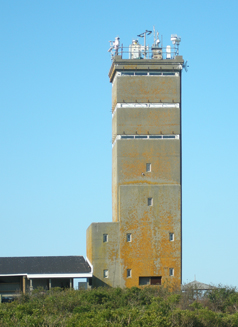At the Head of the Pack
A DECADE AGO it was difficult and labor-intensive for researchers to accurately measure atmospheric mercury. The heavy metal is a highly changeable element that, when captured, can quickly metamorphose into one of its various forms. But since the mid-1990s scientists have been able to routinely probe the heavens for mercury using sophisticated monitors, which can cost upwards of $100,000.
UNH’s AIRMAP program has three such monitors made by Tekran Instruments (to measure all chemical phases) and five other lower-priced mercury monitors as part of its regional network of air monitoring stations. Thus the 10-year-old program is poised to take part in what is becoming an organized, global effort to accurately gauge the environmental toxin in an effort to protect public and environmental health.
The NOAA-funded program is based out of the Climate Change Research Center at EOS and was established to unravel fundamental chemistry-climate connections in New England, which is sometimes referred to the nation's "tailpipe" being downwind of major U.S. urban emission sources. Coal-fired power plants – many of which are located in the industrial Midwest – are a major source of mercury emissions.
Several of AIRMAP’s monitoring sites (observatories) are strategically located to capture these long-range emissions while others, for example, the Appledore Island station located six-miles off the Maine-New Hampshire coast, analyze mercury-rich air from the ocean – a large natural source (and sink) of the chemical.
Long-term, continuous, high-resolution measurements of gaseous elemental mercury, reactive mercury, and particulate-phase mercury are conducted at AIRMAP’s keystone observatory located at Thompson Farm in Durham. (Some 180 other chemicals are also monitored/analyzed at the site.) The site has sampled mercury in five-minute increments continuously for nearly six years. Mercury research at Thompson Farm is funded by NOAA and EPA at approximately $500K each.
Long-term, continuous, high-resolution measurements of gaseous elemental and reactive mercury are done at the Pack Monadnock station in Peterborough, N.H.with a $150K NOAA grant.
The two observatories above are acquiring data to better understand the regional sources and sinks of mercury in New England and also how the element in its different forms changes over time.
Continuous, warm-season, high-resolution measurements of gaseous elemental mercury, reactive mercury, and particulate-phase mercury are done at Appledore Island on the Isles of Shoals and are funded by NSF ($530K) and NOAA ($150K). A two-week intensive campaign was conducted from July 19 to August 2, 2009 to, in combination with the seasonal measurements, understand the mercury cycling in the marine environment.
A 600-foot tower in Farmington, N.H. continuously collects elemental mercury from the mid-boundary layer of the atmosphere and provides a unique view of the chemical’s long-range transport. To make the measurement, a heated, one-inch Teflon tube snakes down the full length of the tower. The heat keeps the mercury in its gas phase and removes water vapor off the tube walls as well.
In the summer of 2008, airborne measurements of gaseous elemental mercury were conducted by an EOS team in the Arctic as part of the Arctic Research of the Composition of the Troposphere from Aircraft and Satellites (ARCTAS) campaign (see cover story in the Summer 2009 issue of Spheres). Funded through NASA's Tropospheric Chemistry Program ($500K to UNH), part of the effort was aimed at understanding the mechanisms causing Arctic mercury depletion events in spring and the impact of boreal fires on mercury in the summertime Arctic.
Mao and Talbot will report their findings at the upcoming December meeting of the American Geophysical Union in San Francisco, CA. -DS
UNH’s AIRMAP program has three such monitors made by Tekran Instruments (to measure all chemical phases) and five other lower-priced mercury monitors as part of its regional network of air monitoring stations. Thus the 10-year-old program is poised to take part in what is becoming an organized, global effort to accurately gauge the environmental toxin in an effort to protect public and environmental health.
The NOAA-funded program is based out of the Climate Change Research Center at EOS and was established to unravel fundamental chemistry-climate connections in New England, which is sometimes referred to the nation's "tailpipe" being downwind of major U.S. urban emission sources. Coal-fired power plants – many of which are located in the industrial Midwest – are a major source of mercury emissions.
Several of AIRMAP’s monitoring sites (observatories) are strategically located to capture these long-range emissions while others, for example, the Appledore Island station located six-miles off the Maine-New Hampshire coast, analyze mercury-rich air from the ocean – a large natural source (and sink) of the chemical.
Long-term, continuous, high-resolution measurements of gaseous elemental mercury, reactive mercury, and particulate-phase mercury are conducted at AIRMAP’s keystone observatory located at Thompson Farm in Durham. (Some 180 other chemicals are also monitored/analyzed at the site.) The site has sampled mercury in five-minute increments continuously for nearly six years. Mercury research at Thompson Farm is funded by NOAA and EPA at approximately $500K each.
Long-term, continuous, high-resolution measurements of gaseous elemental and reactive mercury are done at the Pack Monadnock station in Peterborough, N.H.with a $150K NOAA grant.
The two observatories above are acquiring data to better understand the regional sources and sinks of mercury in New England and also how the element in its different forms changes over time.
Continuous, warm-season, high-resolution measurements of gaseous elemental mercury, reactive mercury, and particulate-phase mercury are done at Appledore Island on the Isles of Shoals and are funded by NSF ($530K) and NOAA ($150K). A two-week intensive campaign was conducted from July 19 to August 2, 2009 to, in combination with the seasonal measurements, understand the mercury cycling in the marine environment.
A 600-foot tower in Farmington, N.H. continuously collects elemental mercury from the mid-boundary layer of the atmosphere and provides a unique view of the chemical’s long-range transport. To make the measurement, a heated, one-inch Teflon tube snakes down the full length of the tower. The heat keeps the mercury in its gas phase and removes water vapor off the tube walls as well.
In the summer of 2008, airborne measurements of gaseous elemental mercury were conducted by an EOS team in the Arctic as part of the Arctic Research of the Composition of the Troposphere from Aircraft and Satellites (ARCTAS) campaign (see cover story in the Summer 2009 issue of Spheres). Funded through NASA's Tropospheric Chemistry Program ($500K to UNH), part of the effort was aimed at understanding the mechanisms causing Arctic mercury depletion events in spring and the impact of boreal fires on mercury in the summertime Arctic.
Mao and Talbot will report their findings at the upcoming December meeting of the American Geophysical Union in San Francisco, CA. -DS
by David Sims, Science Writer, Institute for the Study of Earth, Oceans, and Space. Published in Fall 2009 issue of EOS .

